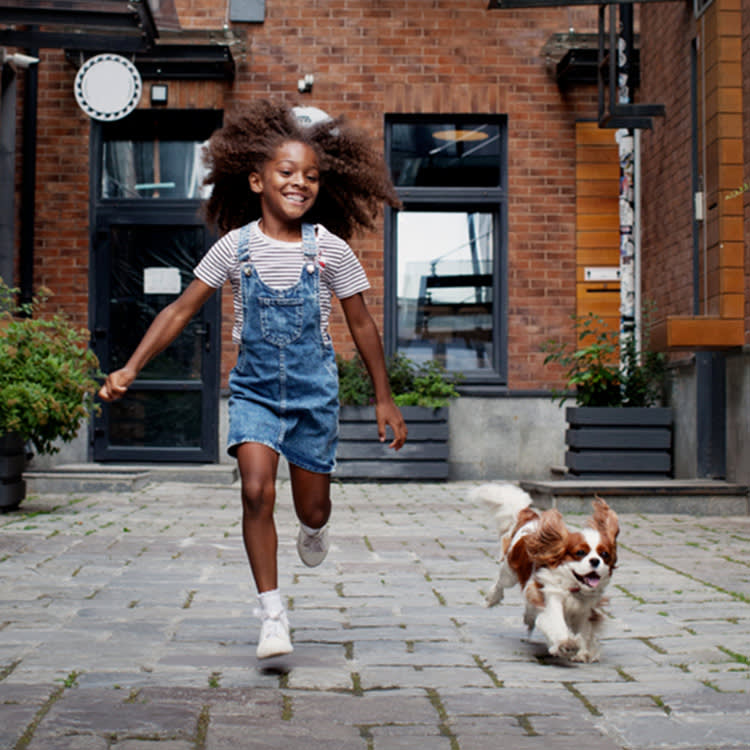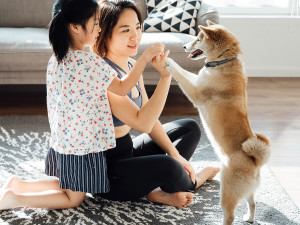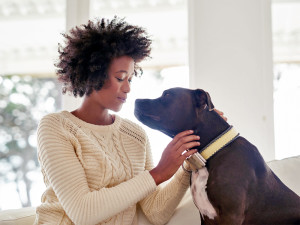Your Daughter’s Right – You Should Get Her a Dog
A new study found that kids, especially young girls, benefit from having a pup

Share Article
All it takes is for one cute puppy to curl up on your daughter’s lap, and she’s sold. The pleas for a dog start early. You tell her she needs to wait until she’s old enough to take care of the pup, or you worry you’ll be the one taking them out for walks. You’ve held strong on your position… until now. Hate to break it to you, but she’s got some pretty strong evidence working in her favour, thanks to a new study.
Research from January shows a strong connection in young kids, especially girls, between getting a dog and being more physically active. Moving more is good for their health, both physical and emotional, which means that acquiring a dog is good for them. The health benefits are probably not the reason kids without dogs are begging their parents to get one, or they would be requesting giant quantities of spinach and broccoli, too, but the findings from the study are reason enough for parents to consider the request.

littleKin™ is Kinship’s home just for puppy and kitten parents. Bop over to check out expert advice, new pet tools, and special deals—all curated for your newest family member.
opens in a new tabThe study was a long-term investigationopens in a new tab of 600 Australian children who were 2–5 years old at the beginning of the study and 5–8 years old by the end of it. The main finding of the research is that getting a dog is associated with a big increase in the amount of physical activity young people do, and that the increase was especially pronounced in girls.
There have been a lot of studies about the benefits of dogsopens in a new tab on adults’ health, but not as many on the ways dogs affect our children’s health. We know dogs provide children with physical health benefits such as minimising allergies and mental health benefits. It also decreases their chances of experiencing anxietyopens in a new tab, something that has been on the rise in recent years as teen girls encounter social media. So, are dogs the solution? Let’s get into it.
The study on kids and dogs
For the research, parents answered questions about their children’s activity, and researchers also directly monitored the kids’ physical activity. The monitoring data showed the speed at which the kids moved and how long they were active.
There were kids who had dogs throughout the study and those who never had one. There were also kids who acquired a dog during the study and those who, unfortunately, lost a dog during it. Of the 600 adolescents in the study, 204 had dogs the whole time, 307 did not have a dog, 58 kids acquired a dog during the study, and 31 lost a dog during the study.
Children who acquired a dog became more active, and those who lost a dog became less active. Girls who got a dog spent 52 minutes more in light activity and games than they did before, but girls who lost a dog were active in this way for 62 minutes less each day than they had been when they had a dog. Boys generally became more active as the study progressed, but the increase in activity was more for boys who had a dog than boys who didn’t – 35 percent more, actually.
Dogs: a girl’s best friend
This study clearly indicates that young people, especially girls, are more active because of their dogs. Many kids don’t get as much exercise as experts recommend for optimal healthopens in a new tab, so knowing that dogs cause a jump in the amount of physical activity they get is important. Kids and teens have a ton of energy, but they also love to sit on their phones and watch TikTok. Getting a dog can get them excited to turn off the screens and get moving.
The increase in physical activity found in this study offers both physical and mental health benefits for young girls. So, if your daughter is saying that you should get a dog, she might have a valid point.
References:

Karen B. London, PhD, CAAB, CPDT-KA
Karen B. London, Ph.D., is a Certified Applied Animal Behaviorist and Certified Professional Dog Trainer who specializes in working with dogs with serious behavioral issues, including aggression, and has also trained other animals including cats, birds, snakes, and insects. She writes the animal column for the Arizona Daily Sun and is an Adjunct Professor in the Department of Biological Sciences at Northern Arizona University. She is the author of six books about training and behavior, including her most recent, Treat Everyone Like a Dog: How a Dog Trainer’s World View Can Improve Your Lifeopens in a new tab.
Related articles
![A man with long brown hair playing tug -of-war with his Golden Retriever dog outside on a wet tennis court]() opens in a new tab
opens in a new tabPlay-Training Can Be Your Solution to Dog Aggression
Behaviour correction, Mary Poppins style: turn a job into a game
![an illustration of a couple kissing, a dog, a couple holding hands, a child, and a child playing with a dog]() opens in a new tab
opens in a new tabIs Raising a Dog With Someone Anything Like Raising a Kid Together?
It’s the great puppy vs baby debate
- opens in a new tab
Why Does My Dog Stare at Me? Possible Reasons and What to Do
Beyond the fact that they’re your biggest admirer
![Young man cuddling little white shih tzu puppy by the Atlantic Ocean.]() opens in a new tab
opens in a new tab9 Myths About Your Puppy – Busted By a Behaviourist
The internet has a lot to tell you about your new addition. Here’s what’s actually true





